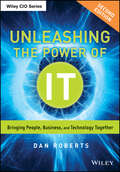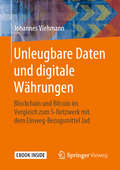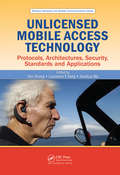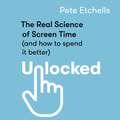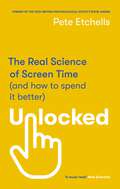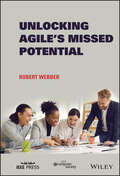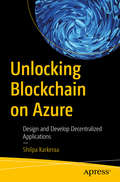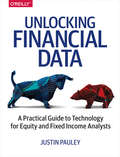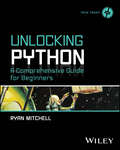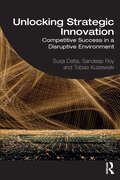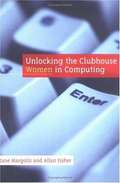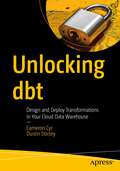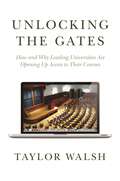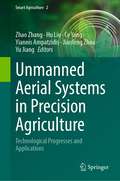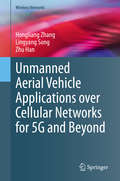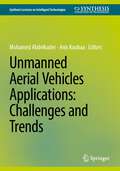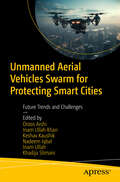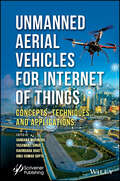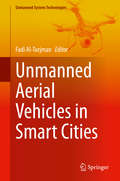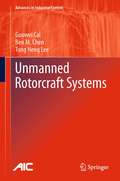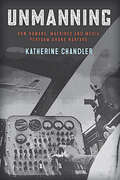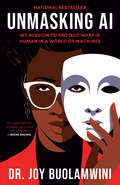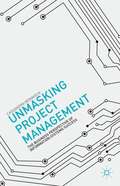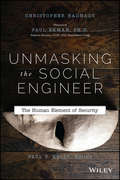- Table View
- List View
Unleashing the Power of IT
by Dan RobertsGo from the "IT guy" to trusted business partnerIf you're in IT, quite a lot is expected of you and your team: be technologically advanced, business-minded, customer-focused, and financially astute, all at once. In the face of unforgiving competition, rampant globalization, and demanding customers, business leaders are discovering that it's absolutely essential to have a strong, active partner keeping a firm hand on the decisions and strategies surrounding information technology. Unleashing the Power of IT provides tangible, hard-hitting, real-world strategies, techniques, and approaches that will immediately transform your IT workforce and culture, presenting the new mindset, skill set, and tool set necessary for IT leaders to thrive in today's challenging environment.Includes new discussion on social mediaOffers online access to the IT Skill Builder Competency Assessment ToolFeatures top ten lists of tips and techniques, proven frameworks, and practical guidance to help you launch and sustain your IT culture change and professional development initiativesProfiling several world-class organizations that have implemented the principles in this book, Unleashing the Power of IT reveals the best practices to get you on the path to implementation.
Unleugbare Daten und digitale Währungen: Blockchain und Bitcoin im Vergleich zum S-Netzwerk mit dem Einweg-Bezugsmittel Jad
by Johannes ViehmannAlte und neue Kryptowährungen: In diesem Buch erfahren Sie alles über alternative WirtschaftssystemeIm Zeitalter der Digitalisierung scheint alles möglich: Produktionen werden automatisiert, die Welt ist miteinander vernetzt und Transaktionen erfolgen nicht mehr nur durch materielles Geld, sondern durch digitale Kryptowährungen. In diesem Buch von Johannes Viehmann werden Ihnen daher unter anderem folgende Begriffe begegnen:BlockchainBitcoin PrimecoinEthereumetc.Sie erhalten einen ersten Eindruck von den aktuell häufig genutzten Kryptowährungen und ihrer Entwicklung in den letzten Jahren. Dank der anschaulichen Darstellung des Inhaltes eignet sich dieses Buch für alle, die ihr Wissen zu digitalen Währungen erweitern und kreativ über die bereits realisierten Kryptowährungen hinausdenken möchten.Das Buch zeigt, wie eine hypothetische ideale Kryptowährung aussehen müssteWie bei allen Geldmitteln kann es auch bei digitalen Währungen zu einer Finanzkrise kommen. Probleme liegen in der Stabilität der Kaufkraft der Kryptowährung und bei der Skalierbarkeit ihrer Transaktionssysteme. Der Autor geht in seinem Buch daher der Frage auf den Grund, wie derlei negative Eigenschaften verhindert werden können und wo die Schwierigkeiten liegen, einer idealen Kryptowährung nahe zu kommen.Das Buch bietet Ihnen eine Alternative, die der Autor selbst auf Basis der Blockchain entwickelt hat: Jad. Dieses Einweg-Nutzmittel könnte auf einem S-Netzwerk zu einer Sammlung von unleugbaren Daten führen. In sieben Kapiteln werden Sie (auch als Anfänger) problemlos in die Welt der Kryptowährungen eingeführt. Das Buch hilft Ihnen zudem dabei, den Zusammenhang zwischen Bitcoin und unleugbaren Daten zu erkennen. Sie lernen mehr über Vertrauenskonzepte, Transaktionen, Technologien und neue digitale Währungen.
Unlicensed Mobile Access Technology: Protocols, Architectures, Security, Standards and Applications
by Laurence T. Yang Jianhua Ma Yan ZhangThe goal of Unlicensed Mobile Access (UMA) is to provide seamless access to GSM and GPRS mobile service networks via unlicensed spectrum technologies, including Bluetooth, WiMAX, and Wi-Fi. Expanding on the level of knowledge in this growing field, Unlicensed Mobile Access Technology: Protocols, Architectures, Security, Standards, and Applications
Unlocked: The Real Science of Screen Time (and how to spend it better)
by Pete Etchells'A welcome counterpoint to the technopanic that screen time is causing a mental health crisis' Bruce Hood 'A rare mix of trustworthy science, practical advice, and human stories ... I'm going to recommend it to all the parents I know, and keep it handy for reference next time I see a scary headline about how technology is ruining our lives' Timandra HarknessMost of us spend a significant part of the day in front of a screen. Our work and social lives play out through our computers, tablets and phones: on email, social media, video conference calls and gaming servers. But what is all this screen time doing to our health, our sleep, and our relationships?Professor Pete Etchells studies the way we use screens, and how they can affect us. In UNLOCKED, he delves into the real science behind the panic about our alleged device addiction and withering attention spans. Armed with the latest research, he reveals how little we have to fear, and the great deal we have to gain, by establishing a more positive relationship with our screens. That begins with asking ourselves some essential questions about how we use them.Instead of clamouring for us to ditch our devices (before guiltily returning to the same old habits), UNLOCKED is a sustainable, realistic and vital guide to transforming our connection with technology.
Unlocked: The Real Science of Screen Time (and how to spend it better)
by Pete Etchells'A welcome counterpoint to the technopanic that screen time is causing a mental health crisis' Bruce Hood 'A rare mix of trustworthy science, practical advice, and human stories ... I'm going to recommend it to all the parents I know, and keep it handy for reference next time I see a scary headline about how technology is ruining our lives' Timandra HarknessMost of us spend a significant part of the day in front of a screen. Our work and social lives play out through our computers, tablets and phones: on email, social media, video conference calls and gaming servers. But what is all this screen time doing to our health, our sleep, and our relationships?Professor Pete Etchells studies the way we use screens, and how they can affect us. In UNLOCKED, he delves into the real science behind the panic about our alleged device addiction and withering attention spans. Armed with the latest research, he reveals how little we have to fear, and the great deal we have to gain, by establishing a more positive relationship with our screens. That begins with asking ourselves some essential questions about how we use them.Instead of clamouring for us to ditch our devices (before guiltily returning to the same old habits), UNLOCKED is a sustainable, realistic and vital guide to transforming our connection with technology.
Unlocked: The Real Science of Screen Time (and how to spend it better)
by Pete Etchells'A welcome counterpoint to the technopanic that screen time is causing a mental health crisis' Bruce Hood'A rare mix of trustworthy science, practical advice, and human stories ... I'm going to recommend it to all the parents I know, and keep it handy for reference next time I see a scary headline about how technology is ruining our lives' Timandra Harkness'Punctures some of the most pernicious myths about our smartphone and screen-dominated lives, while offering good advice about how to improve the time we spend with screens ... a must-read' New ScientistMost of us spend a significant part of the day in front of a screen. Our work and social lives play out through our computers, tablets and phones: on email, social media, video conference calls and gaming servers. But what is all this screen time doing to our health, our sleep, and our relationships?Professor Pete Etchells studies the way we use screens, and how they can affect us. In UNLOCKED, he delves into the real science behind the panic about our alleged device addiction and withering attention spans. Armed with the latest research, he reveals how little we have to fear, and the great deal we have to gain, by establishing a more positive relationship with our screens. That begins with asking ourselves some essential questions about how we use them.Instead of clamouring for us to ditch our devices (before guiltily returning to the same old habits), UNLOCKED is a sustainable, realistic and vital guide to transforming our connection with technology.
Unlocking Agile's Missed Potential
by Robert WebberUNLOCKING AGILE???S MISSED POTENTIAL Agile has not delivered on its promises. The business side expected faster time to market, but they still experience the long delays of bloated releases. Engineers thought they would be given time to build the product right the first time, but they are rushed under pressure to deliver new features within impossible schedules. What went wrong? The culprit is feature-based waterfall release planning perpetuated in a vain attempt to achieve business predictability. Agile didn’t address the business need for multi-year financial predictability. The Agile community’s answer was the naïve response, “The business needs to be more Agile.” Waterfall release planning with fixed schedules undercuts a basic tenet of Agile development – the need to adjust content delivered within a timebox to account for evolving requirements and incorporation of feedback. Agile without flexible content is not Agile. This book introduces a novel solution that enables product teams to deliver higher value within shorter cycle times while meeting the predictability needs of the business. Organizations today want product teams that break down walls between product management and engineering to achieve schedule and financial objectives. Until now they haven’t had a way to implement product teams within the rigid constraints of traditional organizational structures. The Investment planning approach described in this book supports small development increments planned and developed by product teams aligned by common schedule and financial goals. It uses Cost of Delay principles to prioritize work with the highest value and shortest cycle times. Investments provide a vehicle for collaboration and innovation and fulfill the promise of highly motivated self-directed Agile development teams. This book is for engineers, product managers and project managers who want to finally do Agile the way it was envisioned. This book is also for leaders who want to build high-performance teams around the inherent motivational environment of Agile when done right. Foreword by Steve McConnell, author of More Effective Agile: A Roadmap for Software Leaders (Construx Press, 2019).
Unlocking Blockchain on Azure: Design and Develop Decentralized Applications
by Shilpa KarkeraaDesign, architect, and build Blockchain applications with Azure in industrial scenarios to revolutionize conventional processes and data security. This book will empower you to build better decentralized applications that have stronger encryption, better architectures, and effective deployment structures over the cloud. You’ll start with an overview of Blockchain, distributed networks, Azure components in Blockchain, such as Azure Workbench, and independent Blockchain-as-a-service solutions. Next, you’ll move on to aspects of Blockchain transactions where the author discusses encryption and distribution along with practical examples. You’ll cover permissioned Blockchains and distributed ledgers with the help of use cases of financial institutions, followed by code and development aspects of smart contracts. Here, you will learn how to utilise the templates provided by Azure Resource Manager to quickly develop an Ethereum-based smart contract. Further, you will go through Blockchain points of integration, where the author demonstrates enterprise integration, automated processing of smart contracts, and lifecycle events. Finally, you will go through every deployment of HyperLedger, Ethereum, and other decentralized ledger examples over Azure, thus understanding the elements of creation, design, development, security, and deployment. After reading Unlocking Blockchain on Azure you will be able to design and develop Blockchain applications in Azure to decentralize social networks, financial organisations, and data. You’ll be able to implement encryption over a Blockchain and have full control over shared instances digitally. You will be able to program smart contracts to digitize rules and trigger timely transactions.What You Will LearnBuild decentralized applications Program, design, and deploy dynamic smart contractsModel Blockchains in the form of token economics, hybrid networks, and infrastructureDevelop end-to-end encryption and distributed systemsWho This Book Is ForDevelopers and solutions architects who want to develop Blockchain applications in Azure and decentralize applications in different scenarios.
Unlocking Financial Data: A Practical Guide to Technology for Equity and Fixed Income Analysts
by Justin PauleyInvestors recognize that technology is a powerful tool for obtaining and interpreting financial data that could give them the one thing everyone on Wall Street wants: an edge. Yet, many don’t realize that you don’t need to be a programmer to access behind-the-scenes financial information from Bloomberg, IHS Markit, or other systems found at most banks and investment firms.This practical guide teaches analysts a useful subset of Excel skills that will enable them to access and interpret financial information—without any prior programming experience. This book will show analysts, step-by-step, how to quickly produce professional reports that combine their views with Bloomberg or Markit data including historical financials, comparative analysis, and relative value. For portfolio managers, this book demonstrates how to create professional summary reports that contain a high-level view of a portfolio’s performance, growth, risk-adjusted return, and composition. If you are a programmer, this book also contains a parallel path that covers the same topics using C#.Topics include:Access additional data that isn’t visible on Bloomberg screensCreate tables containing corporate data that makes it possible to compare multiple companies, bonds, or loans side-by- sideBuild one-page analytic (“Tear Sheet”) reports for individual companies that incorporates important financials, custom notes, relative value comparison of the company to its peers, and price trends with research analyst targetsBuild two-page portfolio summary report that contains a high-level view of the portfolio’s performance, growth, risk-adjusted return, and compositionExplore daily prices and facility information for most of the tradable corporate bond and loan marketDetermine the relationship between two securities (or index) using correlation and regressionCompare each security’s performance to a cohort made of up of securities with similar risk and return characteristicsMeasure portfolio risk-adjusted return by calculating variance, standard deviation, and Sharpe ratioUse Markit data to identify meaningful trends in prices, new issue spreads, and refinancings
Unlocking Python: A Comprehensive Guide for Beginners
by Ryan MitchellA fun and practical guide to learning Python with a special focus on data science, web scraping, and web applications In Unlocking Python: A Comprehensive Guide for Beginners, veteran software engineer, educator, and author Ryan Mitchell delivers an intuitive, engaging, and practical roadmap to Python programming. The author walks you through the vocabulary, tools, foundational knowledge, and occasional pop-culture references you'll need to hone your skills with this popular programming language. You'll learn how to install and run Python on your own machine, get up and coding with the language quickly, and best practices for programming both independently and in the workplace. You'll also find: Key concepts in computer and data science explained from the ground up Advanced Python topics such as logging, unit testing, multiprocessing, and interacting with databases. Introductions to some of Python's most popular third-party libraries: Flask, Django, Scrapy, Scikit-Learn, Numpy, and Pandas Amusing anecdotes from the trenches of industry Perfect for tech-savvy professionals at any stage of their careers who are interested in diving into Python programming. Unlocking Python is also a must-read for readers who work in a technical role but are interested in getting more directly involved with programming, as well as non-Python programmers who want to apply their technical skill to a new language.
Unlocking Strategic Innovation: Competitive Success in a Disruptive Environment
by Surja Datta Sandeep Roy Tobias KutzewskiThis new book explores how firms achieve competitive advantage in a disruptive, digital and globalized business landscape. An integrative framework, ‘The Four Rs of Competitive Success’, is introduced, which covers the four core pillars of global strategy: resources and capabilities, technology and innovation (recombination), internationalization and international markets (reach), and physical and virtual location (roots). It then explains how competitive advantage is achieved through an interaction of these four drivers against the backdrop of a globalized and digitized world. It is uniquely practical in its approach, combining theoretical understanding with international case studies and real-life examples throughout each chapter, including Apple, IKEA and Microsoft. Unlocking Strategic Innovation is concise, applied reading for postgraduate students studying international business, corporate strategy, innovation and digital strategy, as well as academics in the field. It will also be important reading for practitioners looking to gain further understanding of how firms compete and flourish in a global and technology-driven environment.
Unlocking The Clubhouse: Women In Computing
by Jane Margolis Allan FisherThe information technology revolution is transforming almost every aspect of society, but girls and women are largely out of the loop. Although women surf the Web in equal numbers to men and make a majority of online purchases, few are involved in the design and creation of new technology. It is mostly men whose perspectives and priorities inform the development of computing innovations and who reap the lion's share of the financial rewards. As only a small fraction of high school and college computer science students are female, the field is likely to remain a "male clubhouse," absent major changes. In Unlocking the Clubhouse, social scientist Jane Margolis and computer scientist and educator Allan Fisher examine the many influences contributing to the gender gap in computing. The book is based on interviews with more than 100 computer science students of both sexes from Carnegie Mellon University, a major center of computer science research, over a period of four years, as well as classroom observations and conversations with hundreds of college and high school faculty.
Unlocking dbt: Design and Deploy Transformations in Your Cloud Data Warehouse
by Dustin Dorsey Cameron CyrThis book shows how dbt is used to build data transformation pipelines that enable dependency management and allow for version control and automated testing. It explains how dbt is revolutionizing data transformation and the advantages that a command-line tool like dbt provides over and above the use of database stored procedures and other ETL and ELT tools that handle data transformations. You’ll see how to create custom-written transformations through simple SQL SELECT statements, eliminating the need for boilerplate code and making it easy to incorporate dbt as the transformation layer in your data warehouse pipelines. Additionally, you will learn how dbt enables data teams to incorporate software engineering best practices such as code reusability, version control, and automated testing into the data transformation process. Unlocking dbt walks you through using dbt to establish a project, build and modularize SQL models, and execute jobs in a way that is easy to maintain and scale as your data ecosystem matures. You’ll begin by establishing and configuring a project, a process covered using both dbt Cloud and dbt Core, so that you can confidently stand up a project using either platform. From there, you’ll move into building transformations with peace of mind that your project will scale appropriately as you continue to develop it. After learning the basics needed to get started, you’ll continue to build on that foundation by looking at the unique ways in which dbt combines SQL with Jinja to take your code beyond what is capable in normal SQL. You will learn about advanced materializations, building lineage in your data flows, the unlimited potential of macros, and so much more. This book also explores supported file types and the building of Python models. Rounding things out, you will learn features of dbt that will assist you in making your transformation layer production ready. These include how to implement automated testing, using dbt to generate documentation, and running CI/CD pipelines. What You Will Learn Understand what dbt is and how it is used in the modern data stackSet up a project using both dbt Cloud and dbt CoreConnect a dbt project to a cloud data warehouseBuild SQL and Python models that are scalable and maintainableConfigure development, testing, and production environmentsCapture reusable logic in the form of Jinja macrosIncorporate version control with your data transformation code Who This Book Is For Current and aspiring data professionals, including architects, developers, analysts, engineers, data scientists, and consultants who are beginning the journey of using dbt as part of their data pipeline’s transformation layer. Readers should have a foundational knowledge of writing basic SQL statements, development best practices, and working with data in an analytical context such as a data warehouse.
Unlocking the Gates: How and Why Leading Universities Are Opening Up Access to Their Courses (The William G. Bowen Series #57)
by Taylor WalshHow elite universities are entering the world of online educationOver the past decade, a small revolution has taken place at some of the world's leading universities, as they have started to provide free access to undergraduate course materials—including syllabi, assignments, and lectures—to anyone with an Internet connection. Yale offers high-quality audio and video recordings of a careful selection of popular lectures, MIT supplies digital materials for nearly all of its courses, Carnegie Mellon boasts a purpose-built interactive learning environment, and some of the most selective universities in India have created a vast body of online content in order to reach more of the country's exploding student population. Although they don't offer online credit or degrees, efforts like these are beginning to open up elite institutions—and may foreshadow significant changes in the way all universities approach teaching and learning. Unlocking the Gates is one of the first books to examine this important development.Drawing on a wide range of sources, including extensive interviews with university leaders, Taylor Walsh traces the evolution of these online courseware projects and considers the impact they may have, both inside elite universities and beyond. As economic constraints and concerns over access demand more efficient and creative teaching models, these early initiatives may lead to more substantial innovations in how education is delivered and consumed—even at the best institutions. Unlocking the Gates tells an important story about this form of online learning—and what it might mean for the future of higher education.
Unmanned Aerial Systems in Precision Agriculture: Technological Progresses and Applications (Smart Agriculture #2)
by Hu Liu Zhao Zhang Yu Jiang Jianfeng Zhou Yiannis Ampatzidis Ce YangThis book, consisting of 8 chapters, describes the state-of-the-art technological progress and applications of unmanned aerial vehicles (UAVs) in precision agriculture. It focuses on the UAV application in agriculture, such as crop disease detection, mid-season yield estimation, crop nutrient status, and high-throughput phenotyping. Different from individual papers focusing on a specific application, this book provides a holistic view for readers with a wide range of subjects. In addition to researchers in the areas of plant science, plant pathology, breeding, engineering, it is also intended for undergraduates and graduates who are interested in imaging processing, artificial intelligence in agriculture, precision agriculture, agricultural automation, and robotics.
Unmanned Aerial Vehicle Applications over Cellular Networks for 5G and Beyond (Wireless Networks)
by Zhu Han Lingyang Song Hongliang ZhangThis book discusses how to plan the time-variant placements of the UAVs served as base station (BS)/relay, which is very challenging due to the complicated 3D propagation environments, as well as many other practical constraints such as power and flying speed. Spectrum sharing with existing cellular networks is also investigated in this book. The emerging unmanned aerial vehicles (UAVs) have been playing an increasing role in the military, public, and civil applications. To seamlessly integrate UAVs into future cellular networks, this book will cover two main scenarios of UAV applications as follows. The first type of applications can be referred to as UAV Assisted Cellular Communications.Second type of application is to exploit UAVs for sensing purposes, such as smart agriculture, security monitoring, and traffic surveillance. Due to the limited computation capability of UAVs, the real-time sensory data needs to be transmitted to the BS for real-time data processing. The cellular networks are necessarily committed to support the data transmission for UAVs, which the authors refer to as Cellular assisted UAV Sensing. To support real-time sensing streaming, the authors design joint sensing and communication protocols, develop novel beamforming and estimation algorithms, and study efficient distributed resource optimization methods.This book targets signal processing engineers, computer and information scientists, applied mathematicians and statisticians, as well as systems engineers to carve out the role that analytical and experimental engineering has to play in UAV research and development. Undergraduate students, industry managers, government research agency workers and general readers interested in the fields of communications and networks will also want to read this book.
Unmanned Aerial Vehicles Applications: Challenges and Trends (Synthesis Lectures on Intelligent Technologies)
by Anis Koubaa Mohamed AbdelkaderThis is a book that covers different aspects of UAV technology, including design and development, applications, security and communication, and legal and regulatory challenges. The book is divided into 13 chapters, grouped into four parts. The first part discusses the design and development of UAVs, including ROS customization, structured designs, and intelligent trajectory tracking. The second part explores diverse applications such as search and rescue, monitoring distributed parameter systems, and leveraging drone technology in accounting. The third part focuses on security and communication challenges, including security concerns, multi-UAV systems, and communications security. The final part delves into the legal and regulatory challenges of integrating UAVs into non-segregated airspace. The book serves as a valuable resource for researchers, practitioners, and students in the field of unmanned aerial vehicles, providing a comprehensive understanding of UAV technology and its applications.
Unmanned Aerial Vehicles Swarm for Protecting Smart Cities: Future Trends and Challenges
by Keshav Kaushik Inam Ullah Khan Inam Ullah Oroos Arshi Nadeem Iqbal Khadija SlimaniExplore the intersection between unmanned aerial vehicles (UAVs) and the evolving landscape of smart cities. With the increasing integration of technology into urban environments, there is a growing need to understand how UAV swarms can contribute to the safety, efficiency, and resilience of these complex urban ecosystems. The book aims to provide a technical understanding of UAV swarms and their applications within the context of smart cities. It begins by laying the groundwork with an introduction to UAV swarms and smart cities, establishing the foundational concepts and motivations behind their integration. As the book progresses, it delves into various aspects of smart cities, exploring concepts, technologies, and challenges inherent in their development and operation. This includes discussions on cloud computing, cybersecurity, machine learning applications, surveillance and monitoring systems, urban planning, and infrastructure management. It also examines the integration of IoT devices with UAV swarms, highlighting the synergies between these emerging technologies and their potential impact on urban environments. The book examines cutting-edge topics such as edge computing, blockchain applications, 5G integration, and augmented reality/virtual reality (AR/VR) visualization techniques in the context of UAV swarm operations. It concludes with reflections on innovations and future directions, offering insights into the evolving landscape of UAV swarm technologies and their implications for the protection and advancement of smart cities. The book serves as a comprehensive guide for researchers, practitioners, and policymakers interested in understanding the technical, social, and economic dimensions of UAV swarm technology within the context of smart city development and management. What You Will Learn Identify practical applications of UAV swarms in surveillance monitoring, urban planning, disaster management, and infrastructure resilience Gain comprehensive understanding of UAV swarms by exploring diverse disciplines Apply insights from emerging technologies like cloud computing, machine learning, blockchain, IoT devices, and so on to UAV swarm technology Who Is This Book For This book appeals to a wide range of readers with different interests and backgrounds, including researchers, policymakers, industry stakeholders, practitioners, experts, and general fans who are curious in the confluence of smart cities with UAV swarm technologies with little to no experience or knowledge of UAV swarms.
Unmanned Aerial Vehicles for Internet of Things (IoT): Concepts, Techniques, and Applications
by Yashwant Singh Ravindara Bhatt Anuj Kumar Gupta Vandana MohindruThe 15 chapters in this book explore the theoretical as well as a number of technical research outcomes on all aspects of UAVs. UAVs has widely differing applications such as disaster management, structural inspection, goods delivery, transportation, localization, mapping, pollution and radiation monitoring, search and rescue, farming, etc. The advantages of using UAVs are countless and have led the way for the full integration of UAVs, as intelligent objects into the IoT system. The book covers cover such subjects as: Efficient energy management systems in UAV based IoT networks IoE enabled UAVs Mind-controlled UAV using Brain-Computer Interface (BCI) The importance of AI in realizing autonomous and intelligent flying IoT Blockchain-based solutions for various security issues in UAV-enabled IoT The challenges and threats of UAVs such as hijacking, privacy, cyber-security, and physical safety.
Unmanned Aerial Vehicles in Smart Cities (Unmanned System Technologies)
by Fadi Al-TurjmanThis book addresses the major challenges in realizing unmanned aerial vehicles (UAVs) in IoT-based Smart Cities. The challenges tackled vary from cost and energy efficiency to availability and service quality. The aim of this book is to focus on both the design and implementation aspects of the UAV-based approaches in IoT-enabled smart cities’ applications that are enabled and supported by wireless sensor networks, 5G, and beyond. The contributors mainly focus on data delivery approaches and their performability aspects. This book is meant for readers of varying disciplines who are interested in implementing the smart planet/environments vision via wireless/wired enabling technologies.Involves the most up to date unmanned aerial vehicles (UAV) assessment and evaluation approachesIncludes innovative operational ideas in agriculture, surveillance, rescue, etc.Pertains researchers, scientists, engineers and practitioners in the field of smart cities, IoT, and communicationsFadi Al-Turjman received his Ph.D. from Queen’s University, Canada. He is a full professor and a research center director at Near East University, Nicosia. He is a leading authority in the area of IoT and intelligent systems. His publication history spans over 250 publications in addition to his editorialship in top journals such as the IEEE Communication Surveys and Tutorials, and the Elsevier Sustaibable Cities and Society.
Unmanned Rotorcraft Systems
by Guowei Cai Tong Heng Lee Ben M. ChenUnmanned Rotorcraft Systems explores the research and development of fully-functional miniature UAV (unmanned aerial vehicle) rotorcraft, and provides a complete treatment of the design of autonomous miniature rotorcraft UAVs. The unmanned system is an integration of advanced technologies developed in communications, computing, and control areas, and is an excellent testing ground for trialing and implementing modern control techniques. Included are detailed expositions of systematic hardware construction, software systems integration, aerodynamic modeling; and automatic flight control system design. Emphasis is placed on the cooperative control and flight formation of multiple UAVs, vision-based ground target tracking, and landing on moving platforms. Other issues such as the development of GPS-less indoor micro aerial vehicles and vision-based navigation are also discussed in depth: utilizing the vision-based system for accomplishing ground target tracking, attacking and landing, cooperative control and flight formation of multiple unmanned rotorcraft; and future research directions on the related areas.
Unmanning: How Humans, Machines and Media Perform Drone Warfare (War Culture)
by Katherine ChandlerUnmanning studies the conditions that create unmanned platforms in the United States through a genealogy of experimental, pilotless planes flown between 1936 and 1992. Characteristics often attributed to the drone—including machine-like control, enmity and remoteness—are achieved by displacements between humans and machines that shape a mediated theater of war. Rather than primarily treating the drone as a result of the war on terror, this book examines contemporary targeted killing through a series of failed experiments to develop unmanned flight in the twentieth century. The human, machine and media parts of drone aircraft are organized to make an ostensibly not human framework for war that disavows its political underpinnings as technological advance. These experiments are tied to histories of global control, cybernetics, racism and colonialism. Drone crashes and failures call attention to the significance of human action in making technopolitics that comes to be opposed to “man” and the paradoxes at their basis.
Unmasking AI: My Mission to Protect What Is Human in a World of Machines
by Joy BuolamwiniNATIONAL BESTSELLER • &“The conscience of the AI revolution&” (Fortune) explains how we&’ve arrived at an era of AI harms and oppression, and what we can do to avoid its pitfalls.&“AI is not coming, it&’s here. If we answer the beautiful call inside these pages, we can decide who we are going to be and how we&’re going to use technology in service of what it means to be fully human.&”—Brené Brown, #1 New York Times bestselling author of Dare to Lead A LOS ANGELES TIMES BEST BOOK OF THE YEAR • Shortlisted for the Inc. Non-Obvious Book AwardTo most of us, it seems like recent developments in artificial intelligence emerged out of nowhere to pose unprecedented threats to humankind. But to Dr. Joy Buolamwini, who has been at the forefront of AI research, this moment has been a long time in the making.After tinkering with robotics as a high school student in Memphis and then developing mobile apps in Zambia as a Fulbright fellow, Buolamwini followed her lifelong passion for computer science, engineering, and art to MIT in 2015. As a graduate student at the &“Future Factory,&” she did groundbreaking research that exposed widespread racial and gender bias in AI services from tech giants across the world.Unmasking AI goes beyond the headlines about existential risks produced by Big Tech. It is the remarkable story of how Buolamwini uncovered what she calls &“the coded gaze&”—the evidence of encoded discrimination and exclusion in tech products—and how she galvanized the movement to prevent AI harms by founding the Algorithmic Justice League. Applying an intersectional lens to both the tech industry and the research sector, she shows how racism, sexism, colorism, and ableism can overlap and render broad swaths of humanity &“excoded&” and therefore vulnerable in a world rapidly adopting AI tools. Computers, she reminds us, are reflections of both the aspirations and the limitations of the people who create them.Encouraging experts and non-experts alike to join this fight, Buolamwini writes, &“The rising frontier for civil rights will require algorithmic justice. AI should be for the people and by the people, not just the privileged few.&”
Unmasking Project Management
by Cassandra MoraveckUnmasking Project Management helps professionals in information technology (IT) and business identify successful approaches to management of information systems (MIS) that will work for their organizations and projects.
Unmasking the Social Engineer
by Christopher Hadnagy Dr Paul EkmanLearn to identify the social engineer by non-verbal behavior Unmasking the Social Engineer: The Human Element of Security focuses on combining the science of understanding non-verbal communications with the knowledge of how social engineers, scam artists and con men use these skills to build feelings of trust and rapport in their targets. The author helps readers understand how to identify and detect social engineers and scammers by analyzing their non-verbal behavior. Unmasking the Social Engineer shows how attacks work, explains nonverbal communications, and demonstrates with visuals the connection of non-verbal behavior to social engineering and scamming. Clearly combines both the practical and technical aspects of social engineering security Reveals the various dirty tricks that scammers use Pinpoints what to look for on the nonverbal side to detect the social engineer Sharing proven scientific methodology for reading, understanding, and deciphering non-verbal communications, Unmasking the Social Engineer arms readers with the knowledge needed to help protect their organizations.
